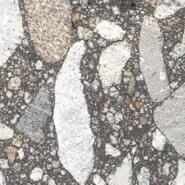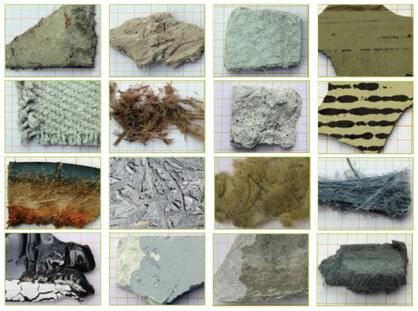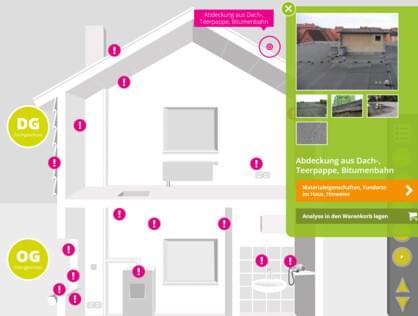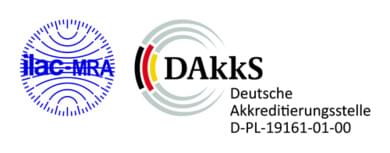Asbestos test needed? Your professional asbestos analysis since 1992 in the independent test laboratory
Since 1992, our accredited laboratory has been providing professional asbestos analysis of material samples, dust samples, air samples from indoor air measurements and workplace measurements, liquids as well as road surfaces, asphalt and rock samples. Trust in over 30 years of experience and benefit from fast and reliable test results.
Analytical services: asbestos tests to test your samples
Asbestos test: We examine these materials for asbestos and this is how you commission an analysis
In our descriptive video, we explain step by step how you can order an asbestos analysis from us. Find out which materials we test for asbestos and how the process works.
What is asbestos?
Asbestos is a collective name for a group of natural, fibrous silicate minerals. These fibers are characterized by their exceptional tensile strength, heat resistance and resistance to chemical influences. Due to these excellent properties, asbestos was used in numerous products and materials, especially in construction, until the 1990s.
Why is asbestos so dangerous?
Asbestos is dangerous due to its fibrous structure and the associated health risks. The individual asbestos fibres are virtually invisible to the naked eye.
If asbestos fibres are released – for example through damage, ageing or improper handling of materials containing asbestos – they can be inhaled and lead to serious diseases in the lungs, which are often not detected until years or decades later.
A common consequence is asbestosis, a hardening and scarring of the lung tissue that restricts respiratory function. Asbestos is also carcinogenic and can cause lung cancer and mesothelioma (tumors of the chest or peritoneum).
Artificial mineral fibres (AMF), which have been used as substitutes for asbestos, are also not harmless. Studies show that they can also pose similar health risks.
When was asbestos used?
Asbestos has been used extensively in Germany since the 1930s. Especially in the 1950s to 1980s, the use of asbestos experienced a peak. During this time, it has been used in numerous construction products, including roof and façade panels, piping, flooring such as "floor flex panels" or "cushion vinyl", plasters, fillers and tile adhesives.
It was not until the 1970s that the health risks of asbestos were increasingly recognised. In Germany, a comprehensive ban on the manufacture, placing on the market and use of asbestos and products containing asbestos came into force on 31 October 1993.
Where in the house are asbestos or artificial mineral fibres found?
Find out where potentially asbestos-containing materials could be located in your home by using the materials finder through our materials library. The interactive graphic "Asbestos in the house" also shows you where asbestos compounds are most common.
Advantages of the asbestos analysis by means of SEM/EDX
- Short processing time, as a rule 3 days after sample receipt
- Reliable analysis by scanning electron microscopy, SEM and X-ray micro analysis, EDX
- Court-proof analysis
- Accredited test procedures, regular participation in collaborative studies
Procedure for detecting asbestos
As an experienced materials analysis laboratory, CRB uses reliable and precise techniques such as scanning electron microscopy (SEM) and X-ray microanalysis (EDX) to determine asbestos for a wide variety of samples.
Scanning Electron Microscopy (SEM)
With scanning electron microscopy (SEM), we can visualize the microscopic fibers of asbestos in your sample. This method allows a detailed view of the fibers, including their length, thickness, and structural features.
The SEM method uses a focused electron beam that scans over the sample. This generates high-resolution images that make it possible to reliably identify asbestos even in very fine particles or highly fragmented samples.
X-ray microanalysis, energy-dispersive X-ray spectroscopy (EDX)
X-ray microanalysis (EDX) is often used in combination with SEM. Here, characteristic X-rays are emitted by the interaction of the electron beam with the sample. The analysis of these X-rays makes it possible to determine the chemical composition of the sample, as each element has a unique X-ray spectrum.
Depending on the type of material in your sample and the expected asbestos concentration, we carry out different preparation and analysis methods. As a private customer, you do not have to worry about choosing the appropriate method when ordering an asbestos test. We take care of that for you.
Advantages of asbestos testing using SEM/EDX
- Fast processing time, approx. 3-4 working days after sample receipt
- Reliable analysis using scanning electron microscopy, SEM & X-ray microanalysis, EDX
- Court-proof test report
- Accredited test methods, regular participation in proficiency tests for asbestos analysis
Asbestos analysis procedure: How to order an asbestos test
Commissioning an asbestos analysis from CRB is simple: you first select the material online and give your sample a unique designation. You then take a sample of the suspect material, pack it airtight, label the sample with the same sample designation and send the sample to our laboratory. Padded envelopes are particularly suitable for the safe shipment of the sample (further information on safe sampling and sample dispatch). Depending on the postal delivery time, your shipment will reach us the next day.
As soon as we have received the sample, we will analyze it and within 3 to 4 working days after receipt of the sample, you will receive a court-proof test report by e-mail.
Please note that CRB does not evaluate the results of the assay or make any evaluation recommendations. If you have any questions about the results, please feel free to contact us. If you would like a professional assessment, you are also welcome to contact us: We will then put you in touch with a competent contact person in your area who can advise you further.
Result of the asbestos analysis: What information does the test report provide?
There are two possible results in an asbestos analysis:
(a) 'containing asbestos: yes' with a classification into quantity classes, or
b) "Asbestos not proven".
In the event of a negative result ("asbestos not proven"), the detection limits specified in the test report are also relevant. Depending on the type of material, the homogeneity and the expected asbestos concentration, different preparation techniques and types of examination are used for the examination of the material samples. You can read more information about the resulting different detection limits here.
Further information on the analysis of material samples and dust samples in accordance with guidelines VDI 3866 sheet 5:2017-06, VDI 3877 sheet 1
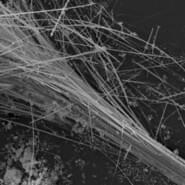
Analysis of material samples and dust samples according to guidelines VDI 3866 Part 5 (2017-06), VDI 3877 Part 1. Asbestos can be found in many places in the house. The following list does not claim to be complete. Examples of the examination of different materials can be found under the menu item
case studies asbestos analysis
Tightly bound asbestos products (asbestos cement, Eternit)
- Roof coverings (flat or corrugated plates)
- Exterior panelling
- Pipes in all areas of building construction and civil engineering
- Vent pipes and flues (gas heating)
- Gardening products like flower boxes or window sills
Chemical construction products
- Bitumen or roofing and sealing membranes
- Floor tiles (flex tiles), adhesives
- Lutings or even putties (sometimes also window putty)
- Joint fillers
- Fillers and sealants
- Coating compounds, anti-corrosion coatings (water engineering)
- Adhesives based on bitumen or resin
weakly bound asbestos products
- Sprayed asbestos or asbestos-containing spray plasters
- Asbestos-containing plasters of light mortars
- Asbestos-containing mats, asbestos boards
- Asbestos –containing light-weight panels
- Loose fill asbestos fibres for stuffing compounds
- Asbestos-containing sealing cords
- Asbestos-containing cords, strips, fabrics, foams
- Floor tiles with a feltpaper like asbestos base, cushioned vinyls
- Air ventilation ducts made of lightweight building boards
- Fire dampers and fireproofing panels in fire doors
- Protective curtains
- Pipe clamps with inserts
- Parts of night storage heaters
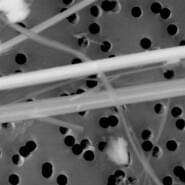
Asbestos analysis of measuring filters from indoor air measurements, analysis of liquids
Evaluation of measuring filters (air, water) for asbestos and artificial mineral fibres in accordance with the guidelines VDI 3492/VDI 3861 Bl. 2/BGI 505-46/ISO 14966
Indoor Air Measurement//Release Measurement//Success Control Measurement//Status Quo Measurement
price list asbestos analysis ambient air, liquids
We only commission partner laboratories or engineering offices/expert offices on site for indoor air measurements and other sampling. Surely there is one near you. Talk to us! You are welcome to use our contact form at the top right.
Ambient air measurements in accordance with VDI 3492, ISO 14966
In accordance with
- The asbestos guidelines of the German federal states (“Guideline for the evaluation of weakly bound asbestos containing products – indoors”)
measurements of the concentration of asbestos fibres in the indoor air must be carried out for the success of asbestos removal and to prove the effectiveness of provisional measures. These measurements are taken in accordance with
- Guideline VDI 3492 “indoor air measurement – ambient air measurement – measurement of inorganic fibrous particles – scanning electron microscopy method”
Workplace measurements in accordance with DGUV Information 213-546 (formerly BGI 505-46)
In accordance with the requirements of the
- The Federal Institute for Occupational Safety and Health (BAuA): Asbestos: Regulations for the protection of employees in the Federal Republic of Germany
as well as European regulations
- DIRECTIVE 2009/148/EC OF THE EUROPEAN PARLIAMENT AND OF THE COUNCIL of 30 November 2009 on the protection of workers from the risks related to exposure to asbestos at work
workplace measurements must be carried out in accordance with
- DGUV Information 213–546 (formerly BGI 505–46 or ZH1/120.46): Analytical methods for the separate determination of the concentrations of respirable inorganic fibres in work areas – scanning electron microscopy method.
Emission measurements according to guideline VDI 3861
Determination of low number concentrations of inorganic fibrous particles in flowing, dry dust-gas mixtures, e.g., in chimneys, pipelines and sewers in accordance with guideline VDI 3861, Part 2 “Stationary source emissions: Measurement of inorganic fibrous particles in exhaust gas – Scanning electron microscopy method”.
Asbestos in liquids
The analysis for asbestos in liquids is made following VDI guideline 3492 “indoor air measurement – ambient air measurement – measurement of inorganic fibrous particles – scanning electron microscopy method”.
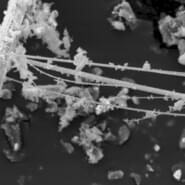
Analysis of hidden products like plasters, fillers and tile adhesives
Qualitative and quantitative Analysis of asbestos bearing plasters, fillers, tile-adhesives according to guidelines VDI 3866 part 5 annex B:2017-06, IFA / BIA-Verfahren 7487, Diskussionspapier VDI / Gesamtverband Schadstoffsanierung, SBH-Methode.
price lists asbestos analysis plasters, fillers

SBH-method
The SBH-method is a procedure developed by the Schulbau Hamburg specified procedure that was and is used for the analysis of paint residues, plasters and fillers that may contain asbestos.
In this process, individual or mixed samples are incinerated at 450 °C and acid-treated to accumulate asbestos in the sample.
Preparation methods of the 'SBH method' are taken up and described in June 2017 in the guideline VDI 3866, sheet 5 and in the short report Asbestos in plasters, fillers and tile adhesives – Refurbishment of Material samples engrossed.
CRB conducts tests of plasters, fillers and tile adhesives in accordance with Annex B of the VDI 3866 guideline, sheet 5:2017-06.
Concealed products such as fillers, tile adhesives and plasters
Recently, concealed products such as fillers, tile adhesives and plasters have increasingly become the focus of attention. Asbestos was often added to these in very small quantities to improve the processing properties of the product. Today, therefore, the asbestos-containing areas are often found under wallpaper or, as in the case of fillered cable slots, they are only present very selectively. These concealed products pose a significant danger to anyone who accidentally and/or improperly handles them. This can lead to significant fiber releases. In particular, buildings that were built or modernized/renovated after the absolute ban on asbestos in 1993, but at least until 1995, are suspected.
Special requirements for laboratory analysis
Since the plasters, fillers and tile adhesives to be examined sometimes have asbestos contents of < 1%, the asbestos in the sample material may be present in a polymer matrix or the asbestos is covered by other polymer aggregates, the sample material must be prepared for laboratory analysis by homogenisation, ashing and acid treatment. Since the preparation of composite samples (see also 'SBH method', an analytical regulation introduced in the Hanseatic City of Hamburg for the examination of school buildings) makes sense in order to reduce the costs of analysis, but the formation of composite samples may lead to a further dilution of the asbestos contents in the laboratory sample, an analytical method with a detection limit of less than 0.01% by weight must be used.
Analytical options for the analysis for asbestos in plasters, fillers and tile adhesives
There are 2 types of investigations based on VDI 3866, sheet 5:2017-06. VDI 3866 takes into account the requirements of the IFA / BIA procedure 7487:1997-04 and ISO 22262-2:2014-09.
1. Qualitative study according to VDI 3866, sheet 5:2017-06
Preparation: ashing, acid treatment, filtration from a suspension onto a nuclear pore filter.
Qualitative result with a mass estimate of the quantity proportion of asbestos according to the mass content classes of VDI 3866, sheet 5, detection limit of the method 0.001 percent by weight.
2. Quantitative study according to VDI 3866, sheet 5:2017-06 based on IFA/BIA procedure 7487
Preparation: ashing, acid treatment, filtration from a suspension onto a nuclear pore filter.
Result quantitatively with an indication of the asbestos concentration in percent by mass. Detection limit of the method 0.001 percent by mass.
top of page
Standards, guidelines concerning asbestos analysis
Freely available guidelines like Technical Rules for the Handling of Hazardous Substances (TRGS), can be found in our
Download area

Analysis of bulk materials, dust samples
- ISO 22262-1:2012-07 – Air quality – Bulk materials – Part 1: Sampling and qualitative determination of asbestos in commercial bulk materials
- ISO 22262-2:2014-09 – Air quality – Bulk materials – Part 2: Quantitative determination of asbestos by gravimetric and microscopical methods
- DIN ISO 22309:2015-11 – Microbeam analysis – Quantitative analysis using energy-dispersive spectrometry (EDS) for elements with an atomic number of 11 (Na) or above.
- VDI 3866 Blatt 1:2000-12 – Determination of asbestos in technical products – Principle – Sampling and sample preparation
- VDI 3866 Blatt 5:2004-10 – Determination of asbestos in technical products – Scanning electrone microscopy method
- VDI 3866 Blatt 5:2017-06 – Determination of asbestos in technical products – Scanning electrone microscopy method
- VDI 3877 Blatt 1:2011-09 – Indoor air pollution – Measurement of fibrous dust on settled on surfaces – Sampling and analysis (SEM/EDX)
- VDI 3877 Blatt 2:2014-12 – Indoor pollution – Measurement of fibrous dusts settled on surfaces – Sampling strategy and assessment of results
- IFA / BIA 7487 (IFA-Arbeitsmappe, Kennzahl 7487):1997-04 – Verfahren zur analytischen Bestimmung geringer Massengehalte von Asbestfasern in Pulvern, Pudern und Stäuben mit SEM/EDX
Analysis of filters from ambient air, liquids
- ISO 14966:2002-11 – Ambient air – Determination of numerical concentration of inorganic fibrous particles – Scanning electron microscopy method
- VDI 3492:2013-06 – Indoor air measurement – Ambient air measurement – Measurement of inorganic fibrous particles – Scanning electron microscopy method
- VDI 3861 Blatt 2:2008-01 – Stationary source emissions – Measurement of inorganic fibrous particles in exhaust gas – Scanning electron microscopy method
- DGUV Information 213-546 (früher BGI 505-46 bzw. ZH1/120.46) – Analysenverfahren zur getrennten Bestimmung der Konzentrationen von lungengängigen anorganischen Fasern in Arbeitsbereichen – Rasterelektronenmikroskopisches Verfahren
Guidelines
- TRGS 517:2013-02 – Tätigkeiten mit potenziell asbesthaltigen mineralischen Rohstoffen und daraus hergestellten Gemischen und Erzeugnissen
- TRGS 519:2014-01 – Asbest: Abbruch-, Sanierungs- oder Instandhaltungsarbeiten
- TRGS 905:2016-03 – Verzeichnis krebserzeugender, keimzellmutagener oder reproduktionstoxischer Stoffe
- Gefahrstoffverordnung:2015-03 – Verordnung zum Schutz vor Gefahrstoffen (Gefahrstoffverordnung – GefStoffV)
Additional information:
- NGS – Merkblatt zur Entsorgung von teerhaltigem Straßenaufbruch, Stand 05/2016
- NGS – Merkblatt zur Entsorgung von asbesthaltigen Abfällen, Stand 04/2016
- Federal Environment Agency – Information on asbestos
top of page
FAQ about asbestos testing
How can you test if you have asbestos?
Simply send a material sample to a specialized laboratory such as CRB, which uses professional analytical methods to check for the presence of asbestos fibers.
Can you test asbestos yourself?
No, asbestos cannot be reliably tested by yourself, as this requires special laboratory techniques.
Who takes asbestos samples?
Asbestos samples should ideally be taken by trained professionals who comply with all safety regulations. For private individuals, we have instructions for correct sampling and shipping.
How does asbestos sampling work?
You carefully remove a small material sample (1 × 1 cm for material samples or the contents of a thimble for dust samples), pack them airtight and send the sample to the laboratory. A detailed explanation can be found under the instructions for correct sampling and sample dispatch.
How much does an asbestos analysis cost?
Depending on the material and analysis method, the costs vary between 73 and 238 euros per sample. An overview of the costs depending on the type of material/analysis can be found in our price list.
How long does an asbestos analysis take?
Asbestos analysis usually takes 3 to 4 working days after receipt of samples. For an extra charge, we also offer a 24-hour express analysis.
How is asbestos analysed?
Asbestos is studied in the laboratory using techniques such as scanning electron microscopy (SEM) or X-ray microanalysis (EDX) to visually identify fibers and determine their chemical composition.
Can asbestos be detected in the air?
Yes, asbestos fibers can be detected in the air. For this purpose, indoor air measurements are carried out, in which a defined amount of air is sucked through a special filter. The fibers contained in the air stick to the filter and can then be analyzed and counted.
How accurate are asbestos tests?
Professional asbestos tests or analyses in an accredited laboratory are very accurate and can reliably detect asbestos fibers in material or dust samples with a detection limit of a few fibers per micrometer.
How do I get an asbestos report?
After the analysis, we will send you a detailed report by e-mail, which lists the results, the analysis procedure and the types of asbestos detected.
What to do if the asbestos results are positive?
In the event of a positive asbestos finding, a certified specialist company should be commissioned to safely remove the affected materials and dispose of them in accordance with legal regulations. Avoid any contact with the affected areas to minimize health hazards.
Can I dispose of asbestos as a private individual?
Private individuals may dispose of firmly bound asbestos products (e.g. asbestos cement panels) under strict safety precautions and only in so-called "big bags", while weakly bound asbestos (e.g . asbestos cardboard) may only be handled by specialist companies that are certified according to TRGS 519. It is generally recommended to leave the disposal to specialized companies.
For more answers to frequently asked questions about asbestos and asbestos analysis, please visit our asbestos FAQ section.


